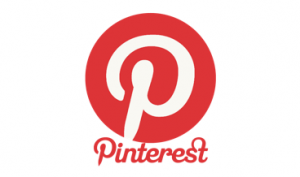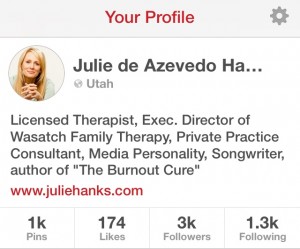 Pinterest is a social media platform that therapists might overlook when building their online presence. It may seem more tailored toward foodies, pop culture junkies, or book lovers than for people wanting or providng professional counseling. However, Pinterest can be a valuable way to serve your online community and also get the word out about yourself and the clinical services you offer.
Joe Sanock, an LPC who also works as a private practice consultant, explains that “People who go on Pinterest are dreaming about having a new life. It could be a new hair style, a new dress, or a renovation. They are in a mindset of change. As counselors, we fit perfectly into that mindset.” He says that Pinterest is his leading referral for both his private practice and consulting business. Bottom line: Pinterest can work as a great marketing tool for you (read more about Joe's experience here).
Pinterest is a social media platform that therapists might overlook when building their online presence. It may seem more tailored toward foodies, pop culture junkies, or book lovers than for people wanting or providng professional counseling. However, Pinterest can be a valuable way to serve your online community and also get the word out about yourself and the clinical services you offer.
Joe Sanock, an LPC who also works as a private practice consultant, explains that “People who go on Pinterest are dreaming about having a new life. It could be a new hair style, a new dress, or a renovation. They are in a mindset of change. As counselors, we fit perfectly into that mindset.” He says that Pinterest is his leading referral for both his private practice and consulting business. Bottom line: Pinterest can work as a great marketing tool for you (read more about Joe's experience here).
Here is some more information and tips for using Pinterest to benefit your practice:
1) Regularly Pin and Re-pin Inspiring and Informative Material
Make a point to pin and re-pin inspiring quotes and ideas that are relevant to your work as a therapist. Quotes about change and personal development often work best. Try to use quotes that are universal enough to not seem super technical or boring, but specific enough to establish that your niche deals with emotional and relational well-being. Use original material as well as curating existing content.
 It’s a good idea to strategically include your name and website links on your graphics or memes (see left for an image I pinned as an example). This can be helpful when you get share and re-pins. It’s more than okay to tap into the promotional side of using Pinterest.
It’s a good idea to strategically include your name and website links on your graphics or memes (see left for an image I pinned as an example). This can be helpful when you get share and re-pins. It’s more than okay to tap into the promotional side of using Pinterest.
There is of course no cut-and-dry rule about how regularly you should post. But as is the case with any social media platform you utilize, you must commit to make content creation and curation an ongoing thing if you want it to make a difference in your marketing; pinning a new picture or idea once every month is not going to do much for establishing and maintaining your online presence.
2) Optimize Your Bio and Profile
The bio at the top of your Pinterest page is your "hello" to new followers. First impressions are important, and you want to introduce yourself professionally and accurately to your viewers. It should have your picture, a clear description of your speciality, and links to your main website. Optimizing your biography is also good for SEO (making your stuff for findable on the web). See screenshot below for my example:
3) Be Deliberate in Selecting Categories and Board Titles
Similar to your biography, be strategic about your titles, categories and boards; they're more important than you might think. Not only do they give a clear indication of the nature of your material, but they're also good for the search engines because your titles are your keywords. Not every one of your boards must be directly related to the field; it's good to diversify and show your followers that you're a multi-dimensional person. For example, you might have a board of humorous memes.
4) Follow Others in Your Niche
And finally, we come to the social part of the social media of Pinterest. Follow other relevant users. Look at the categories and boards of those who re-pin your stuff and see if they are similar to yours. Engage in Pinterest not just for yourself, but use it as a way to learn more and continue to be inspired. Check out other people's pins as well. And yes, follow to be followed (among other reasons).
So there's some tips to get you started or help you more with using Pinterest. It can be a useful tool to engage with the online community, invite more visitors to your website, as well as build your own professional online presence.
What's your experience using Pinterest for your practice?
Get practice tips and blog updates in your inbox.
Sign up for the Private Practice Toolbox Newsletter here.
Join my Private Practice Toolbox Facebook group and connect with 2600 therapists around the globe in 2 simple steps: 1) Click request to join the group and 2) Fill out this brief questionnaire before you'll be added to the group.


As healers, we genuinely like to do our work. Guiding clients through the therapy process and seeing them make progress is why we do what we do. But if you're in private practice, you know there's a lot going on in the back end and that it's crucial to run an efficient and organized business.